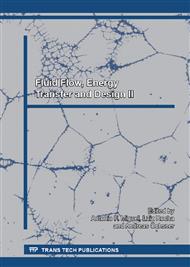[1]
B. Mochnacki, E. Majchrzak, Sensitivity of the skin tissue on the activity of external heat sources, CMES : Comput. Model. Eng. Sci. 4 (2003) 431-438.
Google Scholar
[2]
E. Majchrzak, Application of different variants of the BEM in numerical modeling of bio-heat transfer processes, MCB: Mol. Cell. Biomech., 10 (2013) 201-232.
Google Scholar
[3]
E. Majchrzak, B. Mochnacki, M. Dziewoński, M. Jasiński, Numerical modeling of hyperthermia and hypothermia processes, Comput. Mater. Sci. 268-270 (2011) 257-262.
DOI: 10.4028/www.scientific.net/amr.268-270.257
Google Scholar
[4]
B. Mochnacki, A. Piasecka-Belkhayat, Numerical modeling of skin tissue heating using the interval finite difference method, MCB: Mol. Cell. Biomech. 10 (2013) 233-244.
Google Scholar
[5]
H. Arkin, L.X. Xu, K.R. Holmes, Recent development in modeling heat transfer in blood perfused tissues, IEEE Trans. Biomed. Eng., 41 (1994) 97-107.
DOI: 10.1109/10.284920
Google Scholar
[6]
H. Wang, W. Dai, A. Bejan, Optimal temperature distribution in a 3D triple-layered skin structure embedded with artery and vein vasculature and induced by electromagnetic radiation, Int. J. Heat Mass Transf. 50 (2007) 1843-1854.
DOI: 10.1016/j.ijheatmasstransfer.2006.10.005
Google Scholar
[7]
L. Zhu, S. Weinbaum, A model for heat transfer from embedded blood vessels in two dimensional tissue preparations, J. Biomech. Eng. 117 (1995) 64-73.
DOI: 10.1115/1.2792272
Google Scholar
[8]
R.A. Khaled, K. Vafai, The role of porous media in modeling flow and heat transfer in biological tissues, Int. J. Heat Mass Transf. 46 (2003) 4989–5003.
DOI: 10.1016/s0017-9310(03)00301-6
Google Scholar
[9]
A. Nakayama, F. Kuwahara, A general bioheat transfer model based on the theory of porous media, Int. J. Heat Mass Transf. 51 (2008) 3190–3199.
DOI: 10.1016/j.ijheatmasstransfer.2007.05.030
Google Scholar
[10]
Y. Zhang, Generalized dual-phase lag bioheat equations based on nonequilibrium heat transfer in living biological tissues, Int. J. Heat Mass Transf. 52 (2009) 4829-4834.
DOI: 10.1016/j.ijheatmasstransfer.2009.06.007
Google Scholar
[11]
E. Majchrzak, L. Turchan, Numerical analysis of tissue heating using the generalized dual phase lag model, in: Lodygowski, Rakowski & Litewka (Eds. ), Recent Advances in Computational Mechanics, Taylor and Francis Group, London, 2014, pp.355-362.
DOI: 10.1201/b16513-46
Google Scholar
[12]
B. Mochnacki, Application of the BEM for numerical modelling of continuous casting, Comput. Mech. 18, 1 (1996) 62-71.
DOI: 10.1007/bf00384177
Google Scholar
[13]
E. Majchrzak, B. Mochnacki, M. Jasiński, Numerical modelling of bioheat transfer in multi-layer skin tissue domain subjected to a flash fire, Comput. Fluid Solid Mech. 1-2 (2003) 1766-1770.
DOI: 10.1016/b978-008044046-0.50431-0
Google Scholar
[14]
B. Mochnacki, E. Majchrzak, J.S. Suchy, Boundary element model of coupled heat and mass transfer in solidifying castings, Int. J. Cast. Met. Res., 12, 4 (1999) 227-232.
DOI: 10.1080/13640461.2000.11819359
Google Scholar
[15]
J. Szargut, Thermodynamics, first ed., PWN, Warsaw, 2000 (in Polish).
Google Scholar
[16]
P. Chitrphiromsri, Modeling of thermal performance of firefihter protective clothing during the intense heat exposure, Doctoral Theses, North Carolina State University, Mechanical Engineerig, Raleigh, (2004).
Google Scholar
[17]
E. Majchrzak, B. Mochnacki, Sensitivity analysis and inverse problems in bio-heat transfer modeling, Computer Assisted Mech. Eng. Sc., 13 (2006) 85-108.
Google Scholar
[18]
E. Majchrzak, B. Mochnacki, Sensitivity analysis of transient temperature field in microdomains with resp ect to the dual phase lag model parameters, Int. J. Multiscale Comp. Eng. 12, 1 (2014) 65-77.
DOI: 10.1615/intjmultcompeng.2014007815
Google Scholar
[19]
M. Kleiber, Parameter sensitivity in nonlinear mechanics, first ed., J. Willey & Sons Ltd, Chicester, (1997).
Google Scholar


